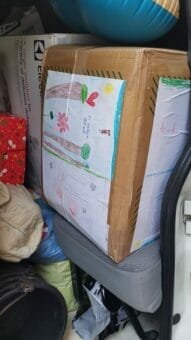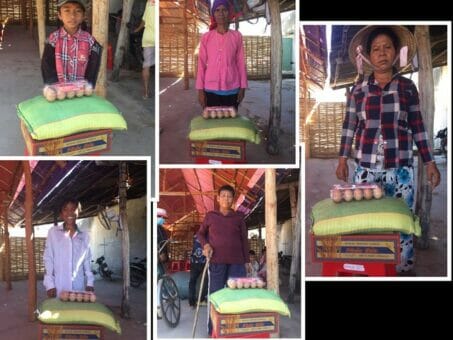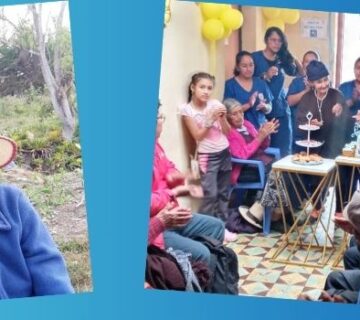Despite the violent clashes in Myanmar, through the work of the “Drop after Drop” (Goccia dopo Goccia) association, the Focolare community continues to bear witness to universal fraternity during a time of pandemic and revolution. Here is the account of the journey undertaken by the focolarini in that area at the beginning of March. (All activities were carried out in accordance with the Covid regulations in the country)
Myanmar is still living through a revolution that began last February on the 22nd of the month: it is called ‘22222’. This country, made up of different ethnic groups and rich in natural beauty and raw materials, experienced the longest civil war in human history from 1947 to 2010. Among the various revolutions that have occured in the past, there was the one that took place on 8 August 1988 called ‘8888’, resulting in thousands of deaths and another in 2007, known as the ‘saffron-coloured’ revolution because of the large number of Buddhist monks who began the protest and lost their lives.
During the clashes in 1988, thousands of people began to migrate towards the border with Thailand, to the province of Tak, to the town of Mae Sot, then in Mae Hong Song, and even further south, towards Kanchanaburi. Today, 32 years later, nine refugee camps are still active: millions of Burmese people who are working in Thailand are living in them.
 The focolarini who have been in the area since 1988 have begun to help many young people who they first met a few years ago in Rangoon and Bassein. “Our contact with them,” says Luigi Butori, a focolarino who lives in Ho Chi Min in Vietnam and who has been travelling in those areas for years, “went on until Father Justine Lewin, a priest linked to the Focolare Movement, arrived in Mae Sot. He helped these people who lived not only in the refugee camps, like the most famous one in Mae La with 50,000 people, but also scattered across the countryside, often close to the factories where they worked, or in the cornfields close to the town of Mae Sot. About twenty years ago we started small projects in the Mae La camp and gradually in the town of Mae Sot. The goal was to feed and clothe the people.”
The focolarini who have been in the area since 1988 have begun to help many young people who they first met a few years ago in Rangoon and Bassein. “Our contact with them,” says Luigi Butori, a focolarino who lives in Ho Chi Min in Vietnam and who has been travelling in those areas for years, “went on until Father Justine Lewin, a priest linked to the Focolare Movement, arrived in Mae Sot. He helped these people who lived not only in the refugee camps, like the most famous one in Mae La with 50,000 people, but also scattered across the countryside, often close to the factories where they worked, or in the cornfields close to the town of Mae Sot. About twenty years ago we started small projects in the Mae La camp and gradually in the town of Mae Sot. The goal was to feed and clothe the people.”
Beginning in 2011, a bridge of solidarity has gradually been built between Italy and Mae Sot. The Focolare community in Latina in central Italy and some students taught by Maria Grazia Fabietti, began to help the children and adults living on the border between Thailand and Myanmar.
Luigi explains, “One of our Italian friends, Paolo Magli was celebrating his 50th birthday and rather than receive lots of presents, he asked for money to help these Karen ethnic groups (a population that fled Burma during the conflicts and has been forced to live as refugees on the border between Myanmar and Thailand for years, some in the Mae La refugee camp and even more in the area outside it.) This was the beginning of “Drop after Drop”. Today, this project helps more than 3300 people in three countries in South East Asia and also collaborates with the Charis association in Singapore to bring help to those affected by poverty, loneliness, disease and even the pandemic. Areas of Vietnam, Thailand and Myanmar give us the ‘possibility to love concretely’: there are people there who know the spirit of universal fraternity and today do everything to help those who are excluded, marginalized, rejected, sick and alone.”
 “Drop after Drop” helps everyone, people from many different ethnic groups – Karen, Bama, Kachin, Thai Yai, and Xtieng and Hmong people in Vietnam. The project also assists Muslims in need who are in contact with the focolare in Bangkok. At the beginning of March, the focolarini went to Mae Sot with a van loaded with food, clothes, toys and much more, as shown in the video you can see below. (The intiative was carried out in accordance with the covid rules in the country). Donations came from Muslims, Buddhists, Christians and many people in contact with the Focolare Movement.
“Drop after Drop” helps everyone, people from many different ethnic groups – Karen, Bama, Kachin, Thai Yai, and Xtieng and Hmong people in Vietnam. The project also assists Muslims in need who are in contact with the focolare in Bangkok. At the beginning of March, the focolarini went to Mae Sot with a van loaded with food, clothes, toys and much more, as shown in the video you can see below. (The intiative was carried out in accordance with the covid rules in the country). Donations came from Muslims, Buddhists, Christians and many people in contact with the Focolare Movement.
Luigi said, “Everyone is our brother or sister. We want to live out in our own situation one of the most beautiful reflections written many years ago by Chiara Lubich, the founder of the Focolare: ‘Lord, give me everyone who is lonely: I have felt in my heart the passion for all of the forsakeness in which the whole world is drifting.’*
The latest project born helps six abandoned mothers and their fifteen children in Mae Sot. We have sent two sewing machines and 15 kg of cotton fabric which can be cut and sewn to make shirts, skirts and trousers for whoever needs them. It is a joy and a celebration to see how people help each other. Universal fraternity is a reality that takes hold, day after day, and “Drop after Drop” represents just that.”
Lorenzo Russo
* Reflection: “Lord give me everyone who is lonely” by Chiara Lubich – September 1949


 Italiano
Italiano Español
Español Français
Français Português
Português




Un grande GRAZIE infinito a tutta la Redazione…e vi aspettiamo a Mae Sot.
Buon giorno.Mi piacerebbe ,se possibile,sapere dove posso contattarvi a Mae Sot,per poter passare un paio di giorni assieme per poter visitare il campo profughi di Mae La.Conosco benissimo la zona,essendo 30 anni circa che viaggio in solitario nel sud-est asiatico.Purtroppo 3 anni fa,prima del covid,ho visitato tutta la frontiera da Mae Sot,Mae Sariang,Mae Sai,Mae Hong Son,ma quando ho cercato di visitare i profughi a Mae La,ho avuto problemi con i militari e non mi hanno fatto passare.Per la fine anno,o anche prima,parto di nuovo,covid permettendo,e sto raccogliendo informazioni in anticipo.Certo di una vostra risposta,vi saluto.
Buongiorno per favore invia una mail a info@focolare.org grazie.